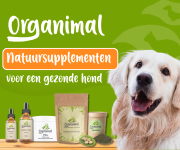Hitam schreef:
Jij doet melasse in je mix, en géén zout. In onderstaande mix zit geen suiker, maar wèl zout.

Ik zou willen gaan experimenteren met de engelse mix, om te beginnen, want deze lijkt mij simpeler uit te voeren.
Maar...ik weet niet of de toevoeging van zout nu wel zo slim is voor een hond.
Denk jij dat zout door het fermenteren verdwijnt, of blijft het gewoon aanwezig?
Eveneens vraag ik mij af of de melasse geheel verdwijnt tijdens het fermenteren?
Wat is beter (gezonder), Tannetje?
Vegetables are controversial ingredients because they’re hard for dogs to digest. But a simple lactofermentation process not only improves the digestibility and assimilation of vegetables, it increases their vitamin content and makes them a valuable source of beneficial bacteria. In fact, the treated vegetables are both a prebiotic (food that feeds beneficial bacteria) and probiotic (food that contains beneficial bacteria). In Europe, lactofermented vegetables are the key ingredient in a popular cancer treatment.
To make lactofermented vegetables (see “It’s All in How You Make It,” March 2001), simply grate, shred, or puree carrots and other vegetables, add 1½ teaspoons unrefined sea salt per quart (4 cups) of vegetables, add the contents of a probiotic supplement such as acidophilus, and press everything in a bowl or glass jar until juice covers the vegetables. (The task is made considerably easier with a Japanese salad press; see “Cancer Prevention Resources” for purchasing information.)
Close the jar tightly or, if using a bowl, cover vegetables with a plate weighted by a jar filled with water. Let stand at room tem-perature until the vegetables give off a vinegar-like fragrance; this will usually take two to three days, depending on their con-sistency and room temperature. Refrigerate. Use to replace vegetables in any home-prepared recipe, or add 1 tablespoon to ¼ cup lactofermented vegetables to each meal.






